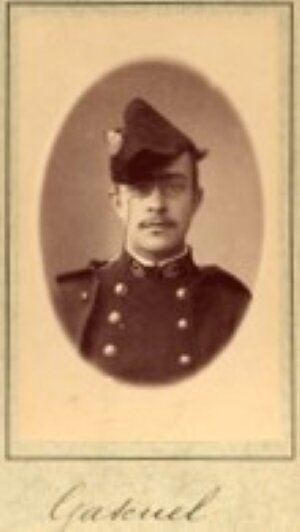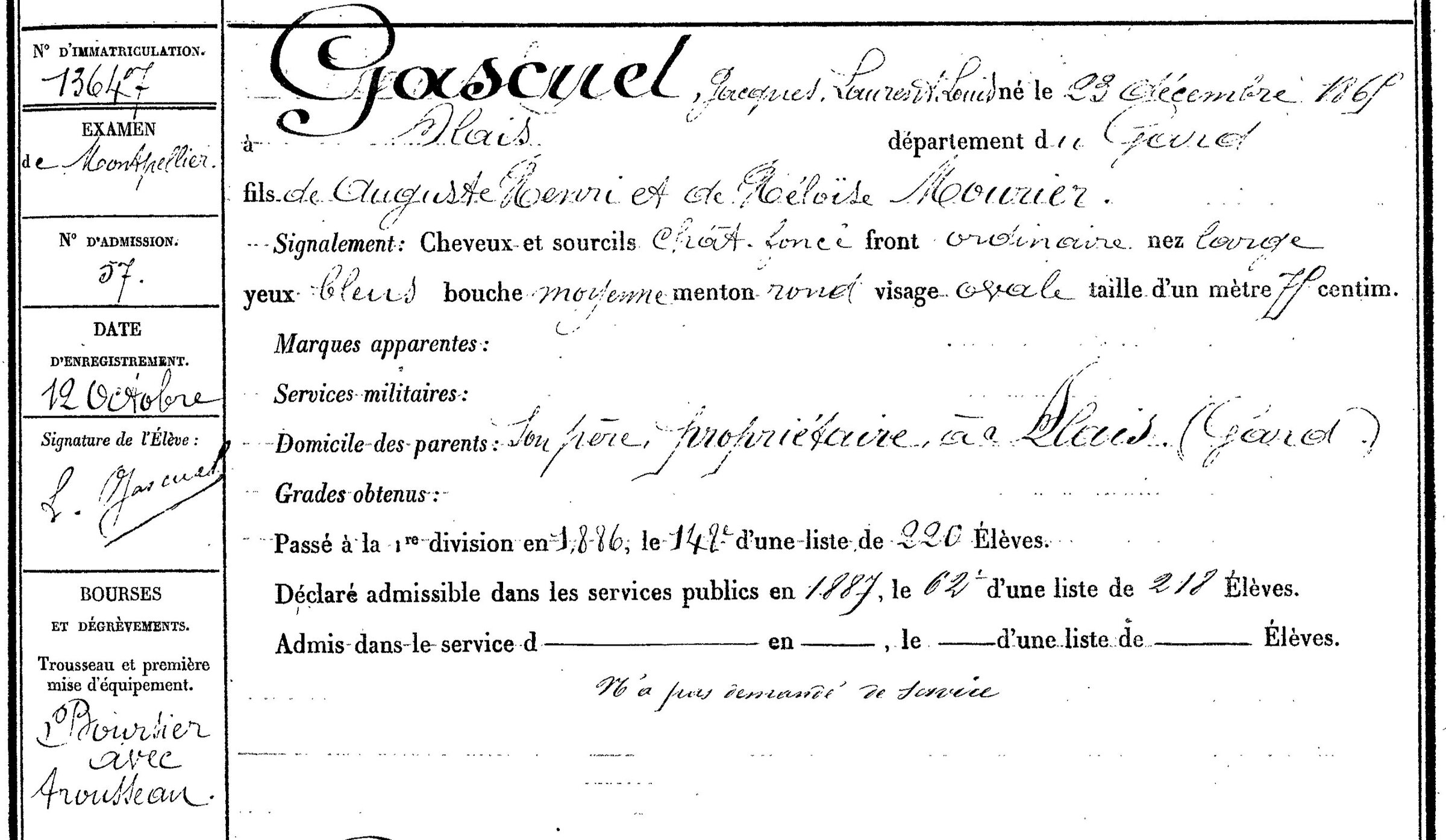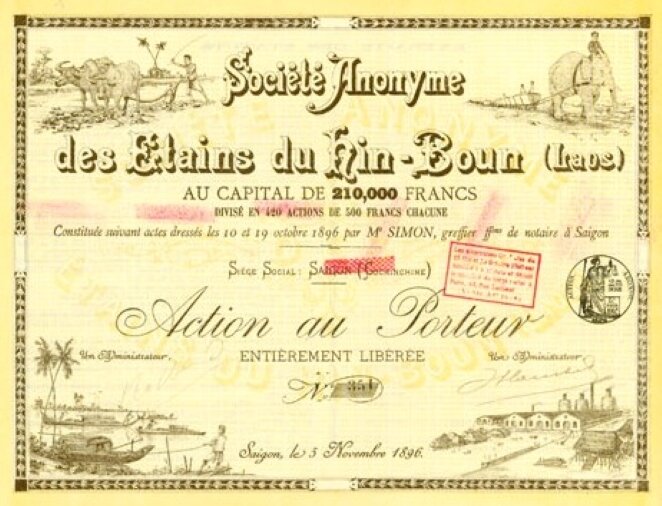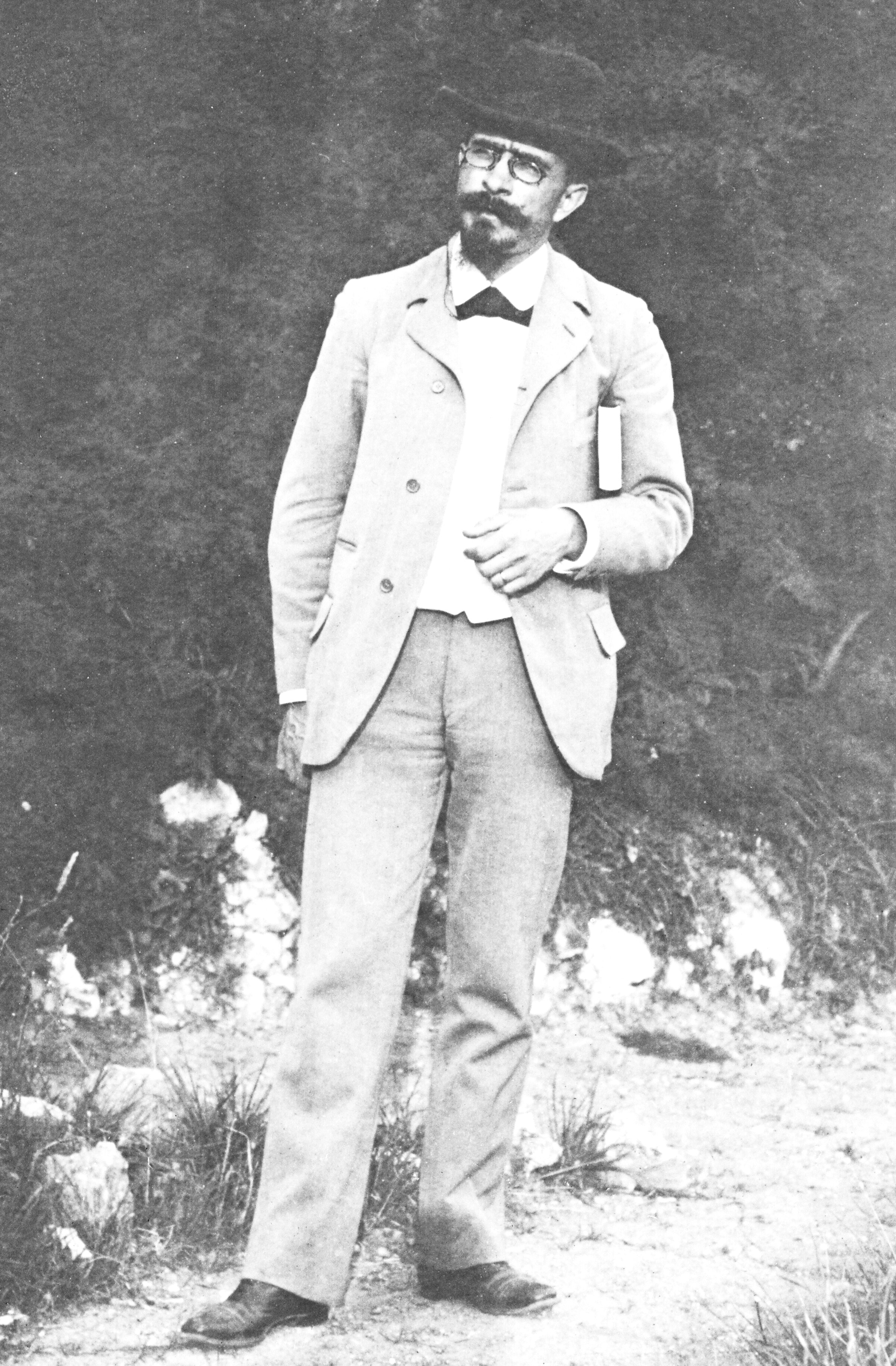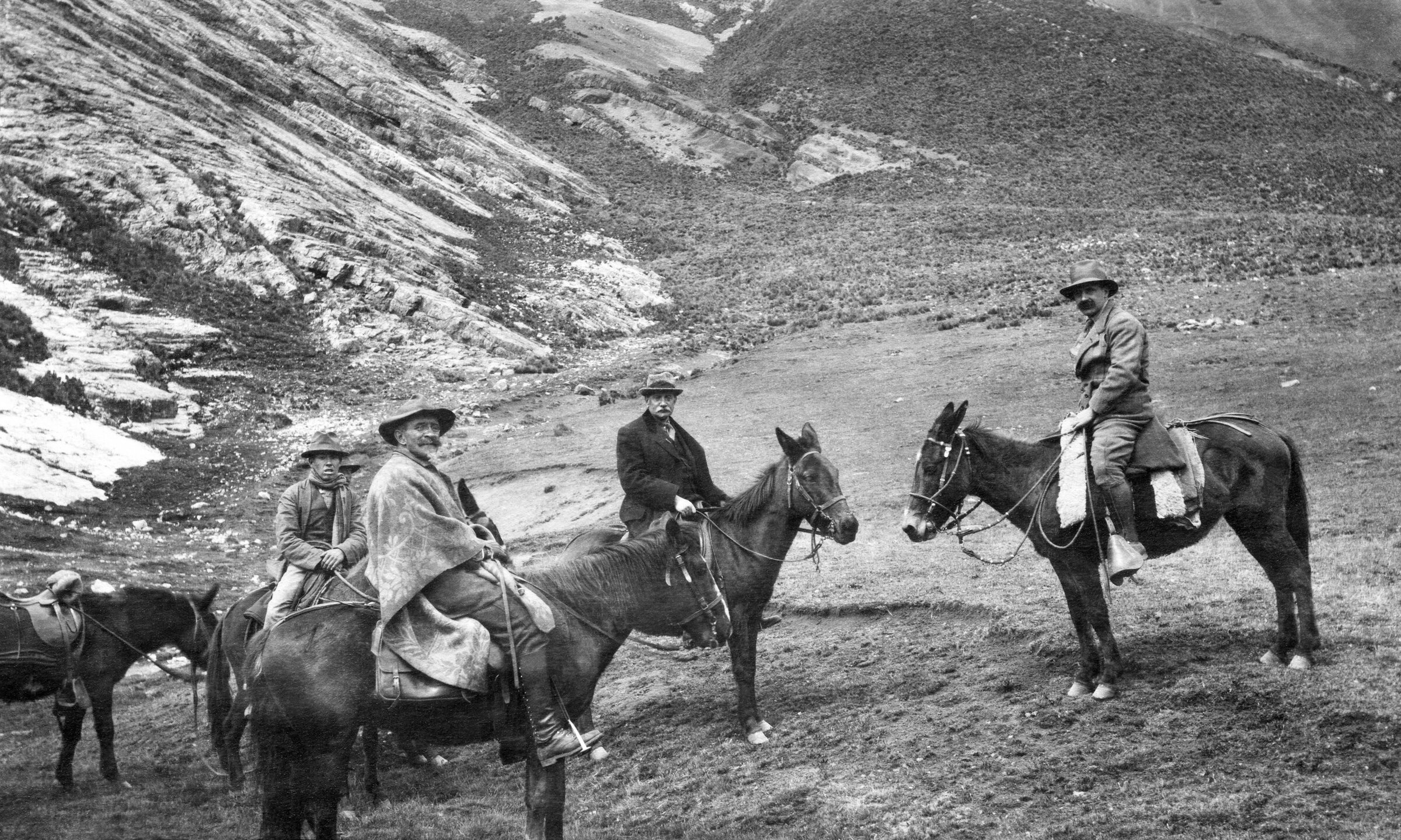Louis Gascuel
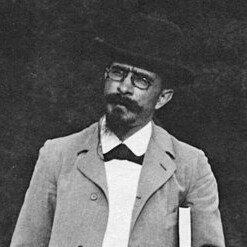
Louis Gascuel (23 Dec. 1865, Alès, France — 12 March 1939, Alès, France) was a mining civil engineer and alumni of École Polytechnique (year group 1885) who visited Cambodia in 1905, on his way to the Hin Boun (Hinboun) tin mines in central Laos, close to the Thai border.
From 1896 to 1923, he traveled the world extensively, first with wife Emma Gascuel (they had married in Le Havre in 1893) for a worldwide tour starting in Australia and New Zeland, then to the USA (1896−1897), followed by a visit to Brazil in 1897 – 1898, and later on his own for mining prospection, for instance to Coolgardie, the Western Australia gold deposit at the core of the 1890s Australian gold rush (up to seven hundred mining companies were based in the town of Coolgardie, established in 1892 and the third largest settlement at the time, were registered with the London Stock Exchange.
In July 1904, the Banque de l’Union Parisienne tasked him with the the assessment of Hin Boun tin deposit, in Laos’ Nam Pathen River Valley, which he reached via Singapore, Saigon and Phnom Penh. When Gascuel inspected the site, the company operating Hin Boun was in trouble: its first prospector, Ménager, had been killed by his Vietnamese workers only two months after its launching, and even if the Société des Etains du Hin Boun had officially received a 1,650 ha concession in 1902 — and a promise from Governor-General Paul Doumer that a road would be built to access this remote, mountainous area -, mining operations were ill-organized, Gascuel estimating the total production at “2 to 3 tons per year”.
Noting that the mine shafts “never go more than five meters below ground, without any wood framing”, that “men dig after the November harverst until February, with women and children carrying away the soil to filter it”, he remarked that the site was “un indescriptible chaos de tas de terre, de blocs amoncelés, d’excavations et de trous de toutes formes” [“an indescribable chaos of piles of earth, piled up blocks, excavations and cavities of all shapes”]. (Gascuel’s report in Annales des Mines 1905)
The colonialist lobby blamed SAEHB’s failure partly on Gascuel’s report, while he was only giving his expert assessment. On 19 May 1919, L’Eveil écononique de l’Indochine railed against what it called a “fiasco”: “En 1902, 113 Annamites et Laotiens étaient employés par la Société, une petite usine traitait 4 tonnes de minerai brut par jour; un arrêté du Gouverneur Général du 3 juin 1903 accordait la Société des Étains du Hin-Boun la concession définitive de trois périmètres miniers dans la vallée de la Nam Patène. Les publications de l’époque se font l’écho de vastes projets de la Société : on devait créer des pâturages, des rizières, on espérait une extraction de 1.200 tonnes d’étain métal ; à Saigon, à la devanture des magasins Jacque, des saumons d’étain de Bao Ta Coua étaient exposés. En août 1903, on annonce que les travaux de recherché et de laboratoire sont terminés, et que l’entreprise va entrer dans la période d’exploitation : le capital des Étains de Hin-Boun va être porté à 3 millions de francs, la moitié étant souscrite à Paris, l’autre moitié étant assurée par la Banque de l’Indochine et la « Société des Mines d’Or ». Après cela, plus rien. Ban Ta Coua sombre dans le silence et dans l’oubli, la Société des Étains du Hin-Boun est dissoute, un de ses principaux actionnaires se refusant à prolonger la vie de la Société, né fut-ce que pour conserver les concessions. Pour n’avoir pas voulu acquitter quelques centaines de francs par an de redevances, le groupe laisse échapper des gisements que la Bourse a capitalisés aujourd’hui à plus d’un milliard. À partir de 1904, semble-t-il, les périmètres sont à qui veut les prendre. Il y a un milliard là, par terre, dans la vallée de la Nam Patème, mais personne né se baisse pour le ramasser. Pourquoi la Société des Étains du Bin-Boun a‑t-elle abandonné la partie ? Nous nous sommes laissé dire qu’elle avait eu affaire à un ingénieur peu compétent et pessimiste. En tout cas, après le qu’elle eût abandonné les gisements, personne né voulut s’y intéresser.” [In 1902, 113 Annamese and Laotians were employed by the Company, a small factory processed 4 tons of raw ore per day; a decree from the Governor General of June 3, 1903 granted the Société des Étains du Hin-Boun the definitive concession of three mining perimeters in the Nam Pathen Valley. Publications of the time lauded the Company’s vast projects: pastures and rice fields were to be created, and 1,200 tons of tin metal were hoped to be extracted; in Saigon, in the windows of Magasins Jacque, tin blocks from Bao Ta Coua were on display. In August 1903, it was announced that the research and laboratory work was completed, and that the company would enter the operating period: the capital of Étains de Hin-Boun would be increased to 3 million francs, half being subscribed to in Paris , the other half being provided by the Bank of Indochina and the “Société des Mines d’Or”. After that, nothing more. Ban Ta Coua sinks into silence and oblivion, the Hin-Boun Tin Company is dissolved, one of its main shareholders refusing to prolong the life of the Company, if only to preserve the concessions. To not have unwilling to pay a few hundred francs per year in royalties, the group let slip deposits that the Stock Exchange has today capitalized at more than a billion. From 1904, it seems, the perimeters are for whoever wants to take them. There are a billion there, on the ground, in the valley of the Nam Patème, but no one bends down to to pick it up. Why did the Société des Etains du Bin-Boun abandon the game? We were told that it had dealt with an incompetent and pessimistic engineer. In any case, now that she had abandoned the deposits, no one wanted to be interested in them.”]
Louis Gascuel also traveled to Borneo and Sebuku Islands in 1901 and 1906, and to Algeria (Ain Sefra in 1901, Constantine in 1908).
From August to December 1909, Louis Gascuel went on a mission to Carocoro, Savanilla (Colombia), Guayaquil (Ecuador), Arequipa (Peru), La Paz (Bolivia), Santiago de Chile (Chile), and was back to Peru from October 1910 to March 1911, spending most of his time there from 1913 to 1920. Two Peruvian mining sites occupied him: The Huarón mine, a vast polymetallic (Zn-Pb-Ag-Cu) deposit in central Peru, one of the largest silver reserve in the world exploited since 1912 and operated since 2001 by Pan American Silver; and the three major silver mining sites of the Cerro de Pasco area, already mined by the Spaniards and taken over in 1913 by a “syndicate” aggregating some of the wealthiest American investors like James Ben Ali Haggin, Alfred W. McCune, George and Phoebe Hearst, J. P. Morgan, Henry Clay Frick and the Vanderbilts.
A member of the Société des américanistes since 1921, Louis Gascuel was an accomplished amateur photographer, and brought back from his travels more than 1,000 photographs on quarter (6 x 9 cm) glass plates, always dating and captioning them. One of his great-granddaughters, Ms. Anne Gascuel, has recently completed the restoration and digizitization of negatives taken from the plates.
Publications:
- “Notes sur les champs d’or de Coolgardie” (Dunod ed., Paris, 1899)
- “Note sur le district cuprifère de Walloroo (Australie du Sud)” (Dunod, Paris, 23p.,1900?)
- “Les Gisements diamantifères de la région sud-est de l’île de Bornéo, possessions hollandaises” (1901)
- “Société anonyme des étains du Hin-Boun, Laos. Rapports de MM. L. Gascuel et J. S. Mac Arthur” (1905)
- “Gisements stannifères au Laos français”, in Annales des Mines, serie 10, vol 8, September 1905, pp 321 – 31.
- “L’Or à Madagascar” (1906)
- “Le gisement de Cerro de Pasco (Pérou)”, in Annales des Mines, XVII, p, 660 (1913?).
References:
- Alfred Lacroix, “Sur les gisements stannifères de Hin-Boun (Laos)”, Bulletin de la Société française de Minéralogie, volume 24, 8, 1901. pp. 422 – 425 [in French].
- Marc Mouscadet, “L’exploitation des ressources du sous-sol au Laos à l’époque coloniale de 1893 à 1940”, INALCO/HTSM, Paris, 2013) [in French].
[Thanks to Alain Gascuel, one of Louis Gascuel’s grandsons, a former journalist and founder of Cambodge Nouveau magazine (1994−2014), for pointing this research to us, and to Anne Gascuel for sharing her research on her ancestor’s archive.]
- Related Photos

